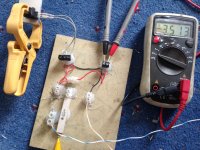Sorry to ask silly questions, but a question if I may regarding the matching of output transistors.
If you were to purchase say 40 transistors, and lets say for example a device from the IRF—family, what sort of variation in characteristics could be reasonably expected, if the only criteria was “same manufacturer” and “same batch”
Secondly, how does subjective performance alter with mismatched, maybe even slightly mismatched transistors?
I have been reading with interest many of the posts in the PASS forum, and the efforts that are required and indeed have been undertaken by many constructors in the matching of O/ P devices.
Comments will be greatly appreciated.
If you were to purchase say 40 transistors, and lets say for example a device from the IRF—family, what sort of variation in characteristics could be reasonably expected, if the only criteria was “same manufacturer” and “same batch”
Secondly, how does subjective performance alter with mismatched, maybe even slightly mismatched transistors?
I have been reading with interest many of the posts in the PASS forum, and the efforts that are required and indeed have been undertaken by many constructors in the matching of O/ P devices.
Comments will be greatly appreciated.
Hi Geevee,
In the MOSFets example, you could expect some variation in the level of doping and oxide thickness; this in turn would impact the threshold voltage and the overall conduction characteristic: some devices would have a somewhat lower threshold, higher transconductance and lower on-resistance, while others would show opposite deviations; the level of variation is difficult to predict, but I'd venture to say something in the low tens of percent.
The effect of such mismatches on the complete amplifier is also difficult to predict, and will depend essentially on the actual circuit: mainly on the level of feedback, local and global: the higher the feddback, the lower the effect.
LV
In the MOSFets example, you could expect some variation in the level of doping and oxide thickness; this in turn would impact the threshold voltage and the overall conduction characteristic: some devices would have a somewhat lower threshold, higher transconductance and lower on-resistance, while others would show opposite deviations; the level of variation is difficult to predict, but I'd venture to say something in the low tens of percent.
The effect of such mismatches on the complete amplifier is also difficult to predict, and will depend essentially on the actual circuit: mainly on the level of feedback, local and global: the higher the feddback, the lower the effect.
LV
GeeVee said:Hi Elvee
Thanks for your response-appreciated.
Is the effect of mismatched O/P devices more prevalent in mosfets than say bipolars, or just does it come down to topology and circuit configuration?
Regards,
George.
For bipolars, it will depend very much on the topology: if the output characterisic of the stage depends strongly on the beta of transistor (which is not recommended, but nevertheless the case in some designs praised by audio gurus), then mismatching may have a significant effect, since the beta of transistors tends to show considerable dispersion.
If on the other hand the circuit is relatively immune to beta variation, which is the case for usual output topologies, then mismatching will only have a minor influence, because other parameters, such as transconductance, and the initial Vbe level required to reach a certain current are dependent on silicon properties, and/or junction area.
LV
Hi,
it's easy to measure Vgs of a FET with simple equipment.
Fets vary more than BJTs and vertical FETs more than lateral FETs and Pchannel more than Nchannel.
This only becomes an issue in output stages when you run two or more devices in parallel. The source resistor tries to balance currents but on it's own it does a bad job of equal current sharing. You need to match. Once output current starts to flow then the source resistors have a better effect on current sharing due the higher voltage drop across Rs when the higher output current flows through it.
it's easy to measure Vgs of a FET with simple equipment.
Fets vary more than BJTs and vertical FETs more than lateral FETs and Pchannel more than Nchannel.
This only becomes an issue in output stages when you run two or more devices in parallel. The source resistor tries to balance currents but on it's own it does a bad job of equal current sharing. You need to match. Once output current starts to flow then the source resistors have a better effect on current sharing due the higher voltage drop across Rs when the higher output current flows through it.
Clamping two mosfets to the plate, one on each side and thus back to back will keep them at nearly the same temperature.
You can then use one as DUT and the other as REF.
Batch all your REFs
Then finally install two (almost matching) REFs into the test jig and recheck for accuracy of matching.
Make sure the source resistor of the LTP pair is zero ohms, otherwise the feedback around the source resistor hides the errors between devices.
You can then use one as DUT and the other as REF.
Batch all your REFs
Then finally install two (almost matching) REFs into the test jig and recheck for accuracy of matching.
Make sure the source resistor of the LTP pair is zero ohms, otherwise the feedback around the source resistor hides the errors between devices.
- Status
- This old topic is closed. If you want to reopen this topic, contact a moderator using the "Report Post" button.
- Home
- Amplifiers
- Solid State
- Question regarding matching O/P devices.
